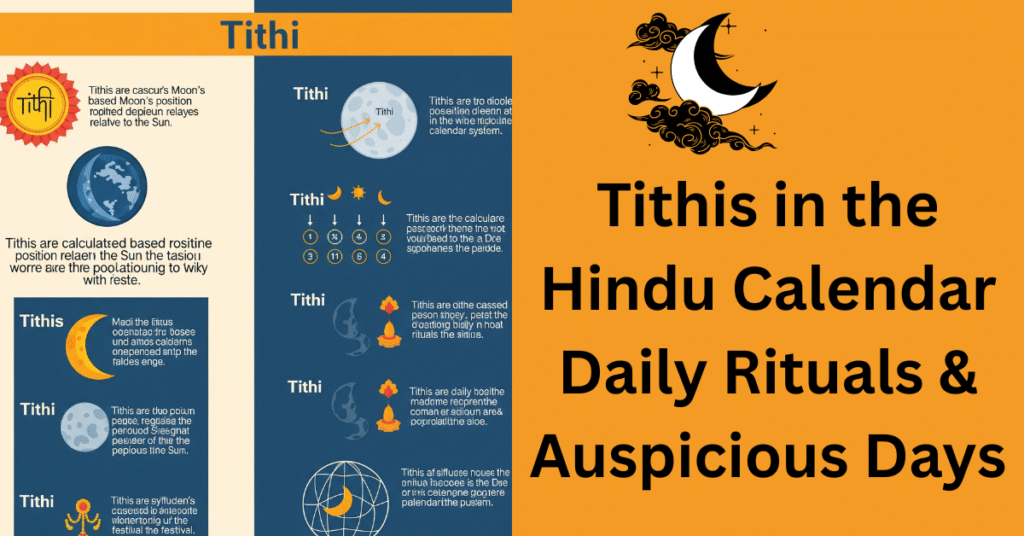
Hindu Tithi Calculator
Calculate the lunar day according to the Hindu calendar. Discover the significance of Tithi in Vedic astrology and plan your religious activities accordingly.
Understanding Tithi in Hindu Calendar
What is Tithi?
Tithi is a lunar day in the Hindu calendar, representing one of the 30 phases of the Moon’s waxing and waning cycle. Each Tithi is approximately 0.948 of a solar day, making the lunar month about 29.5 solar days.
Significance of Tithi
Tithis play a crucial role in determining Hindu festivals, auspicious days, and religious ceremonies. Each Tithi has its own spiritual significance and is associated with specific deities and rituals. The Tithi at the time of birth is considered important in Vedic astrology for creating a Janam Kundali (birth chart).
Types of Tithis
The 30 Tithis are divided into two Pakshas (fortnights):
- Shukla Paksha (Waxing Moon): 15 Tithis from Pratipada (first day) to Purnima (full moon)
- Krishna Paksha (Waning Moon): 15 Tithis from Pratipada to Amavasya (new moon)
Major Tithis and Their Importance
Certain Tithis hold special significance in Hindu tradition:
- Ekadashi (11th day): Dedicated to Lord Vishnu, observed with fasting
- Purnima (Full Moon): Celebrates abundance and completion
- Amavasya (New Moon): Dedicated to ancestors, important for rituals
- Chaturthi (4th day): Dedicated to Lord Ganesha
- Ashtami (8th day): Dedicated to Goddess Durga
Scientific Basis of Tithi
Tithi is calculated based on the longitudinal angle between the Sun and Moon. When the angle reaches 12°, a new Tithi begins. This astronomical relationship creates the 30-phase lunar cycle that forms the basis of the Hindu calendar system.
Calculate Tithi
Significance:
Panchami Tithi is associated with the Nag Devta (serpent god) and is considered auspicious for starting educational activities. It’s also good for housewarming ceremonies and artistic endeavors.
Auspicious Tithis
Pratipada, Panchami, Shashthi, Ekadashi, Trayodashi, and Purnima are generally considered auspicious for new beginnings and important events.
Inauspicious Tithis
Chaturdashi, Amavasya, Ashtami, and Navami are sometimes considered challenging and require special consideration for important activities.
Special Tithis
Ekadashi (fasting), Purnima (full moon rituals), Amavasya (ancestor worship), and Chaturthi (Ganesh worship) have special observances.
1. What is a Tithi in the Hindu calendar?
A Tithi is a lunar day in the Hindu calendar, based on the angle between the Moon and the Sun.
2. How many Tithis are there in a Hindu month?
There are 30 Tithis in a lunar month—15 in Shukla Paksha (waxing phase) and 15 in Krishna Paksha (waning phase).
3. What is the difference between Shukla Paksha and Krishna Paksha?
Shukla Paksha refers to the bright half (from New Moon to Full Moon), while Krishna Paksha is the dark half (Full Moon to New Moon).
4. How long is a Tithi?
A Tithi lasts between 19 to 26 hours, depending on the movement of the Moon.
5. What is the first Tithi of the lunar month?
The first Tithi is Pratipada, followed by Dwitiya, Tritiya, and so on.
6. What is Amavasya and Purnima?
Amavasya is the New Moon day (end of Krishna Paksha), and Purnima is the Full Moon day (end of Shukla Paksha).
7. Why is Tithi important in Hinduism?
Tithis are used to determine auspicious times for rituals, fasts, festivals, and marriages.
8. How is Tithi calculated?
Tithi is calculated by the angular distance (12° segments) between the Sun and Moon.
9. Which Tithi is good for marriage?
Generally, Dvitiya, Tritiya, Panchami, Saptami, Dashami, Ekadashi, Dwadashi, and Trayodashi are considered auspicious, depending on nakshatra and yoga.
10. Can Tithi change in a single day?
Yes, Tithis can begin or end at any time of day or night as per lunar motion.
11. How is Tithi different from the English date?
A Tithi follows the lunar cycle, while English dates follow the solar calendar. So they don't align regularly.
12. What tools can I use to check the Tithi?
You can use Panchangs, Hindu calendar apps, or an online Tithi Calculator to find the exact tithi.
13. What is the Tithi of Krishna Janmashtami?
Janmashtami falls on the Ashtami Tithi of Krishna Paksha in the month of Bhadrapada.
14. Which Tithi is considered inauspicious?
Generally, Amavasya and Ashtami are avoided for major functions, though exceptions exist.
15. Is Tithi same across all locations?
Tithi may slightly vary depending on location due to time zone differences and moonrise/moonset timing.
16. Why do festivals depend on Tithi?
Tithis represent the spiritual and energetic nature of the Moon’s phases, which are crucial for Vedic rituals.
17. What is the importance of Ekadashi Tithi?
Ekadashi is considered highly auspicious for fasting and spiritual cleansing.
18. Can I do puja on any Tithi?
Yes, but some Tithis are more suitable for specific rituals. Panchang consultation is preferred.
19. What is the spiritual meaning of a Tithi?
Each Tithi has a vibration or energy connected to different deities and cosmic forces.
20. Is Tithi relevant in astrology (Jyotish)?
Yes, Tithi is one of the Panchang elements (Tithi, Nakshatra, Yoga, Karana, Vaar) used in astrological predictions and muhurat selection.
Leave a Reply